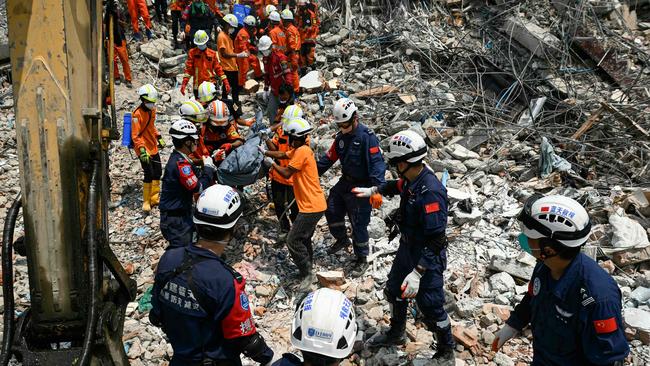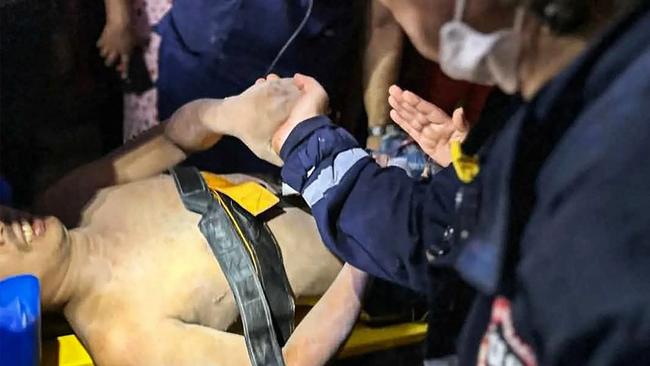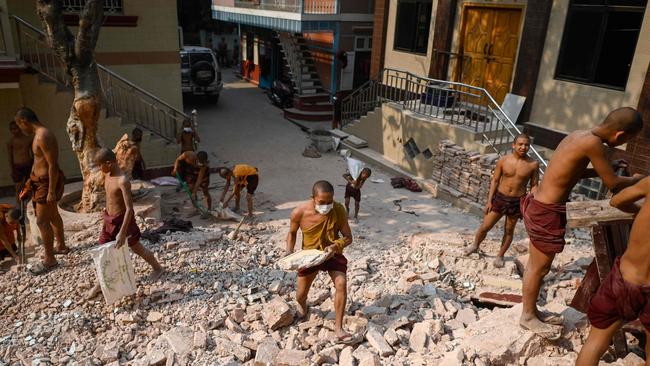Myanmar junta announces temporary ceasefire after quake as miracle survivor pulled from rubble
The military regime has been widely condemned for continuing to bomb resistance strongholds since Friday’s earthquake, putting survivors and aid distribution at risk.

Myanmar’s ruling military has announced a temporary ceasefire in its fight against armed groups opposed to its rule, as the death toll from a devastating earthquake rose and desperate survivors pleaded for more help.
The military government said it would observe a ceasefire from Wednesday until April 22 to make relief efforts easier, after other armed groups fighting the country’s bloody four-year civil war made similar pledges.
In a statement late Wednesday, the junta said the ceasefire had “the aim of speeding up relief and reconstruction efforts, and maintaining peace and stability”.
But it warned its opponents -- a complex array of pro-democracy and ethnic minority armed groups -- it would still respond to attacks, acts of sabotage or “gathering, organising, and expanding territory that would undermine peace”.
The military regime has been widely condemned for continuing to bomb resistance strongholds since Friday’s earthquake, putting survivors and aid distribution at risk.
Junta chief Min Aung Hlaing was expected to travel to Bangkok on Thursday for a regional summit, to discuss the quake response.
The trip would be a rare foreign excursion for the head of the isolated nation. Since seizing power in a February 2021 coup, he has mostly only travelled to his main arms supplier Russia, and main economic partner and political backer China.

The proposed temporary pause in fighting came as a 26-year-old man was pulled alive from the ruins of a hotel in the Myanmar capital of Naypyidaw a full five days after a 7.7 magnitude earthquake devastated large swathes of the country.
Despite vanishingly small odds of finding anyone still alive amid the devastation, a joint team of Turkish and Myanmar emergency crews rescued the man just after midnight on Wednesday, the Myanmar Fire Department and ruling junta said.
Dazed and dusty but conscious, the man was pulled through a hole in the rubble and put on a stretcher, video posted on Facebook by the Myanmar Fire Services Department shows.
It was a rare glimmer of good news amid a rising official death toll expected to exceed 3000 on Wednesday as aid agencies warned time was running out to deliver urgent supplies of fresh water, food and medicines to stricken communities across the conflict-torn country.
“The needs are massive, and they are rising by the hour,“ UNICEF country director Julia Rees said after touring some of the worst-affected areas, adding many children with serious injuries needed urgent care. “The window for lifesaving response is closing. Across the affected areas, families are facing acute shortages of clean water, food and medical supplies.”
“Many are deeply traumatised, having lost loved ones or been pulled from the rubble themselves. The longer we wait, the deeper the impact on children’s lives and futures.”
Critical shortages grip Myanmar after the quake as hospitals overflow and services collapse. Mandalay quake survivors face no aid, failing services, and displacement as hospitals struggle and the military remains inactive.
Emergency aid from pre-positioned supplies was starting to reach areas of need on Wednesday, but the UN has warned the humanitarian response to the catastrophe remains “critically underfunded” with just 5 per cent of the target $US1.1bn ($1.7bn) needed raised.
Volunteer workers on the ground told The Australian delivery of lifesaving supplies into areas such as Sagaing, at the epicentre of Friday’s 7.7 magnitude earthquake, were being severely hampered by traffic gridlocks as survivors fled by vehicle and on foot for safer districts.
“Traffic jams are really a challenge now,” said Aung Thin Kyaw (not her real name), a student volunteer in rebel-held Sagaing which has been a stronghold of the popular resistance to military rule since the February 2021 coup that ousted the democratic government of Aung San Suu Kyi.
“We are getting food and fresh water in but medical aid and heavy machinery is still not easy to get and supplies of tents and shelters still haven’t arrived.
“I estimate 90 per cent of the city’s population is now living outside and with all the dead bodies decomposing it is a real health risk for locals. The city is in desperate need of proper equipment, medical assistance and organised relief efforts to prevent further casualties and deteriorating conditions.”
Concerns over a rising risk of disease – from dengue and cholera to respiratory infections and measles – are being compounded by a looming monsoon while military restrictions and air strikes on rebel-held areas are also obstructing aid.
Earlier on Wednesday, Foreign Minister Penny Wong said the reported air strikes “exacerbated the suffering of the people”.
“We condemn these acts and call on the military regime to immediately cease military operations and allow full humanitarian access to affected areas,” she said.
More than two dozen search and rescue teams from 13 nations continued to sift through the wreckage of buildings in major towns and cities across a swathe of central and northwest Myanmar in search of survivors on Wednesday.
But in many places volunteers were still toiling with their bare hands to free people.
In one video, workers can be seen desperately working to extricate a little girl buried up to her neck in rubble while trying to keep her fading spirits up.

Outside the Sky Villa condominium compound in Mandalay, now just mammoth piles of twisted metal and broken concrete, relatives waited anxiously as workers and machinery sifted through the destruction.
Shwe Sin said she believed her daughter was “just stuck in the building rather than being on the list of deaths”.
“I believe my daughter is still alive but I have no hope at the moment,” she said.
In neighbouring Thailand, the number of people killed climbed to 21 on Wednesday as Thai PM Paetongtarn Shinawatra ordered an investigation into the collapse of a 32-storey building under construction where as many as 70 people are believed to remain trapped.
The building’s collapse has reignited longstanding concerns over construction safety and the structural integrity of Chinese-built projects in the city amid speculation the Chinese state construction company responsible had cut safety corners.
Late on Tuesday, Myanmar junta chief Min Aung Hlaing confirmed his country’s death toll had reached 2719 and was expected to rise to more than 3000 as more bodies were pulled from the wreckage. At least 4521 people were injured and another 441 missing.
Myanmar’s shadow National Unity Government, comprising former MPs and ethnic leaders, on Sunday declared its People’s Defence Forces would observe a partial two-week ceasefire.
On Tuesday the Three Brotherhood Alliance, a trio of rebel armies that have dealt the most devastating blows to the military in the ongoing four year civil conflict sparked by its February 2021 coup, announced its own one-month ceasefire to assist urgent humanitarian efforts.
But in a speech to launch an emergency appeal fund Min Aung Hlaing ruled out any halt to military operations, saying it would continue to target ethnic armed groups – including those that have declared a ceasefire – deemed to be planning future attacks.
Crisis Group Myanmar researcher Richard Horsey said the junta’s refusal to call a ceasefire underscored its own weakness.
“Once again they are putting regime survival above the interests of the people, even at a time of calamity.”
with AFP





To join the conversation, please log in. Don't have an account? Register
Join the conversation, you are commenting as Logout